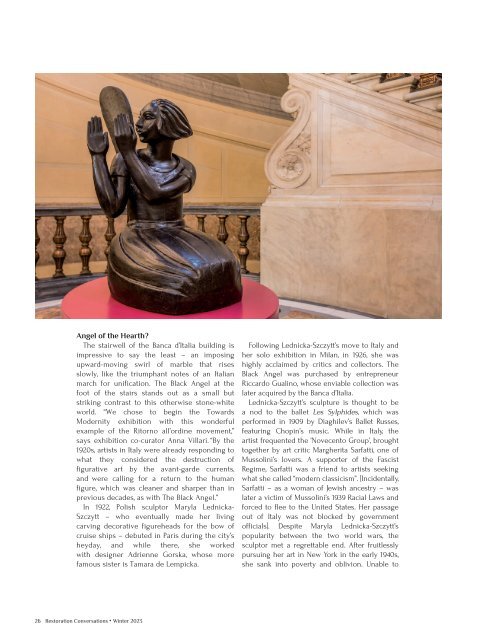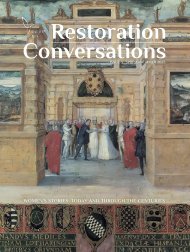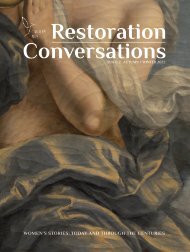Winter 2023
Restoration Conversations is a digital magazine spotlighting the achievements of women in history and today. We produce two issues a year: Spring/Summer and Fall/Winter
Restoration Conversations is a digital magazine spotlighting the achievements of women in history and today. We produce two issues a year: Spring/Summer and Fall/Winter
You also want an ePaper? Increase the reach of your titles
YUMPU automatically turns print PDFs into web optimized ePapers that Google loves.
Angel of the Hearth?<br />
The stairwell of the Banca d’Italia building is<br />
impressive to say the least – an imposing<br />
upward-moving swirl of marble that rises<br />
slowly, like the triumphant notes of an Italian<br />
march for unification. The Black Angel at the<br />
foot of the stairs stands out as a small but<br />
striking contrast to this otherwise stone-white<br />
world. “We chose to begin the Towards<br />
Modernity exhibition with this wonderful<br />
example of the Ritorno all’ordine movement,”<br />
says exhibition co-curator Anna Villari. “By the<br />
1920s, artists in Italy were already responding to<br />
what they considered the destruction of<br />
figurative art by the avant-garde currents,<br />
and were calling for a return to the human<br />
figure, which was cleaner and sharper than in<br />
previous decades, as with The Black Angel.”<br />
In 1922, Polish sculptor Maryla Lednicka-<br />
Szczytt – who eventually made her living<br />
carving decorative figureheads for the bow of<br />
cruise ships – debuted in Paris during the city’s<br />
heyday, and while there, she worked<br />
with designer Adrienne Gorska, whose more<br />
famous sister is Tamara de Lempicka.<br />
Following Lednicka-Szczytt’s move to Italy and<br />
her solo exhibition in Milan, in 1926, she was<br />
highly acclaimed by critics and collectors. The<br />
Black Angel was purchased by entrepreneur<br />
Riccardo Gualino, whose enviable collection was<br />
later acquired by the Banca d’Italia.<br />
Lednicka-Szczytt’s sculpture is thought to be<br />
a nod to the ballet Les Sylphides, which was<br />
performed in 1909 by Diaghilev’s Ballet Russes,<br />
featuring Chopin’s music. While in Italy, the<br />
artist frequented the ‘Novecento Group’, brought<br />
together by art critic Margherita Sarfatti, one of<br />
Mussolini’s lovers. A supporter of the Fascist<br />
Regime, Sarfatti was a friend to artists seeking<br />
what she called “modern classicism”. [Incidentally,<br />
Sarfatti – as a woman of Jewish ancestry – was<br />
later a victim of Mussolini’s 1939 Racial Laws and<br />
forced to flee to the United States. Her passage<br />
out of Italy was not blocked by government<br />
officials]. Despite Maryla Lednicka-Szczytt’s<br />
popularity between the two world wars, the<br />
sculptor met a regrettable end. After fruitlessly<br />
pursuing her art in New York in the early 1940s,<br />
she sank into poverty and oblivion. Unable to<br />
26 Restoration Conversations • <strong>Winter</strong> <strong>2023</strong>





